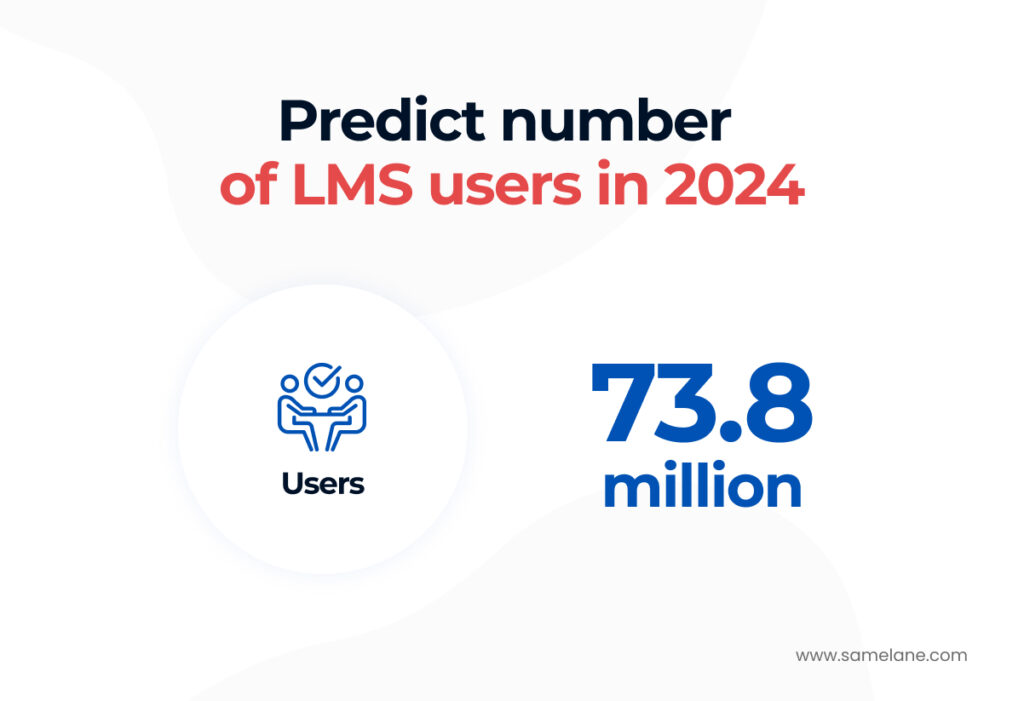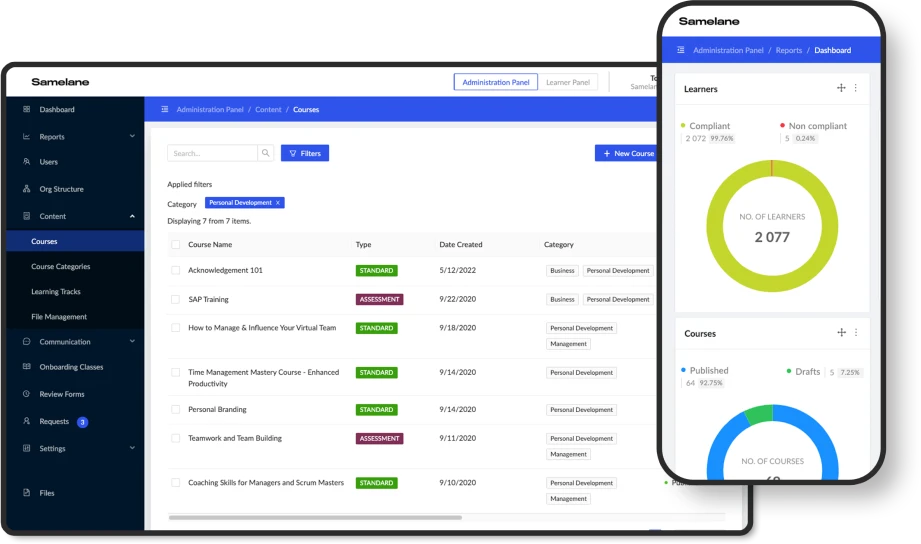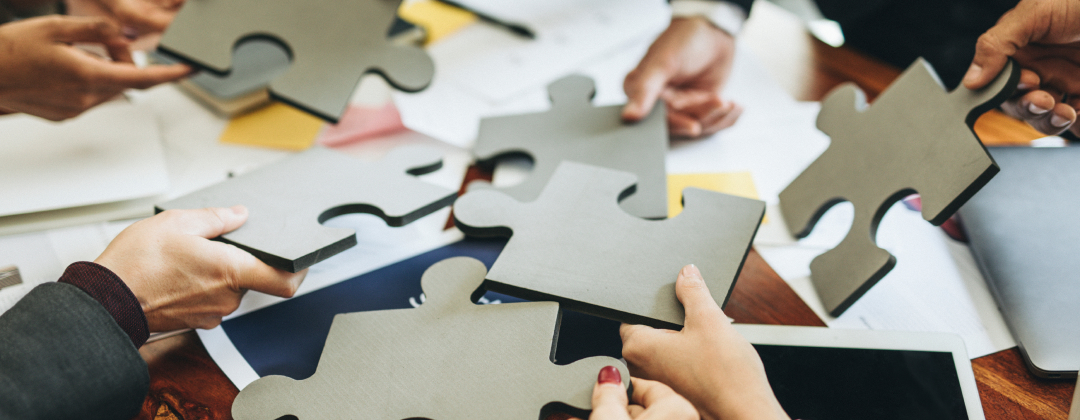We’re undergoing the digital transformation, which is gaining momentum and starting to demand active participation from the business. We came to live in exciting times with digitization pressing organizations to seek more efficient and adaptable solutions for learning management and employee development.
The estimated number of LMS users in 2024 is 73.8 million1 and is still increasing. That figure reflects the dynamic growth of the LMS segment and the demand for education streamlining solutions. As a result, the LMS industry continues to grow significantly, substantially increasing user’ count and market value. We may expect LMS providers to deliver more efficient solutions facilitating employee productivity and mobility shortly.

We have collected data and trends in L&D to provide critical facts and directions to allow you to make data-driven decisions for your employees’ effective learning. So, let’s look into the numbers!
Key LMS statistics for 2024
The growing LMS market
The latest research shows that the LMS market is expected to reach $28.1 billion by the end of 2025, while by 2030, it’s anticipated to reach almost $70 Billion with an impressive CAGR of 19.2%2. Factors contributing to this growth include:
- Government initiatives.
- Increasing adoption of digital learning.
- Integration of artificial intelligence and machine learning in LMS systems.
As a result, the LMS market is expected to grow from $16,2 in 2022 to $22.4 billion in 2023, resulting in the global e-learning market growing at 14% annually3, while during the forecast period (2024 to 2031) & projected to reach USD 12089.07 Million by 2031!4

While Europe is emerging as the fastest-growing market, North America remains the largest. Also, the corporate end-user segment of LMS is projected to register the highest growth rate over the forecast period. Furthermore, web-based LMS platforms are prevalent, with about 87% of active users showing a widespread preference for online learning tools, while cloud-based LMS adoption in Europe stands at 12.5%5.
Regional trends and growth drivers
The LMS market has seen significant growth in adoption across the world. North America is in the lead regarding regional adoption and global market share, with over 33.1% in 2022. Meanwhile, Europe turns out to be the fastest-growing market. On-premises services dominate the market, but their demand is expected to decline in the coming years.
North America accounted for the highest market share, over 33.1% in 2022, due to the established presence of various market players. Regarding the consumer type, the corporate segment accounted for the highest market share of learning management systems users in 20226.
Several drivers fuel the LMS sector. On the one hand, we deal with the growing globalization of the workforce and remote or hybrid work, requiring a multilingual and elastic approach toward employee development. Therefore, an adjustable and multifunctional platform is necessary for big companies to keep a coherent knowledge flow. On the other hand, organizations look at savings, though they still emphasize the quality and importance of training. Referring to the Learning Management System Market Size in 2024, the observed LMS growth is also driven by technological advancements, increasingly popular blended learning, data-based education, and government support for education technology in some markets.
Top factors driving LMS adoption
The adoption of Learning Management Systems is propelled by various factors that can vary depending on the specific needs and circumstances of the organization. However, we can distinguish some of the top and universal ones:
Remote learning opportunities
The rise of remote work and education has increased the need for online learning platforms, leading to increased adoption of LMS.
Scalability
LMS accommodates many users, making it suitable for small and large organizations.
Cost-effectiveness
Using a Learning Management System can be more cost-effective than traditional in-person training or education, as it eliminates physical materials and allows for self-paced learning.
Standardization of training
LMS allows for standardizing training materials across an organization, ensuring that all employees or students receive the same information.
Customization and personalization
Many LMS platforms allow for the customization of learning materials to suit the specific needs of the organization or the individual learner.
Tracking and reporting
LMS often include robust tracking and reporting features, which can help organizations monitor learner progress and identify areas for improvement.
Integration with other systems
Many Learning Management Systems can be integrated with other software systems (such as HR or CRM), making managing and tracking learning more manageable.
Regulatory compliance
In some industries, organizations must provide specific training to their employees, and a Learning Management System (LMS) can help ensure that this training is delivered consistently and that completion is tracked correctly.
Ease of access
An LMS allows learners to access learning materials from anywhere, at any time, which can increase learner engagement and completion rates.
Future-proofing education and training
With the digitization of many aspects of life, adopting an LMS is a way to future-proof education and training processes.

Future LMS trends to look out for
The use of technology in the education sector is increasing, with 48% of students using desktop computers, 42% using smartphones, 33% using interactive whiteboards, and 20% using tablet devices. In addition, trends such as mobile learning are signaling a shift towards more technologically advanced teaching paradigms7.
Other trends to look out for shortly include the increased application of cloud-based solutions and the use of blockchain in education. According to current data, cloud-based LMS adoption in Europe stood at 12.5% in 2023, indicating a shift towards more flexible, scalable, and cost-effective LMS solutions8. Meanwhile, blockchain technology, on the other hand, can be used to verify and secure digital transcripts and credentials, providing a new way to manage and certify learning achievements.
Apart from the technological trends and technical features, we are also looking into the potential hidden in the LMS agility and adaptability. Organizations reach for learning tools to deliver more cohesive solutions in areas that can fuel productivity and mobility. The future of the LMS industry is expected to be driven by the following trends:
- Customizable configurations: The best LMS platforms allow customization to meet specific organizational needs. It can include creating groups and organizing learning content by department, job role, or specific training needs. Areas of customization can include onboarding, product and systems training, sales enablement, coaching and leadership training, upskilling, and industry and company language.
- Microlearning: With attention span shortening, microlearning has become a key trend in LMS. Microlearning provides information in small, easily digestible pieces, which leads to better engagement, absorption, and retention of information. It is ideal for people on the go and can dedicate little time to one training module.
- Collaborative coaching capabilities: Coaching through an LMS simplifies the process for managers to follow employee progress and give feedback. With AI integrations, intuitive data reporting allows easy progress tracking and identifying areas where learners need improvement.
- Real-time analytics: Predictions about education in the future need to be rooted in actionable analytics. Data collection and learning metrics allow you to determine the effectiveness of your company’s training programs. Key metrics include employee activity, progress, assessment, completion rates, learning scores, and overall satisfaction. Every LMS will have different reporting abilities, so deciding what’s essential for your company’s purposes is vital before choosing your learning management system9.
Keep up with the digital revolution.
The LMS industry is expanding and evolving, driven by the increasing use of digital learning and the demand for quality education. Understanding the industry dynamics, key players, and potential challenges is crucial to make the most of these systems.
Educators and organizations can effectively leverage LMS to enhance learning outcomes by staying informed and making data-driven decisions. Keeping up with the digital revolution, particularly in e-learning, requires a proactive approach to technology, understanding learners’ needs, and incorporating them into your workforce training strategies.
By staying on top of the changing landscape of digital learning and remaining flexible and open to new approaches, you can ensure your employee development strategies remain practical and relevant.
Book a free demo to try Samelane for your organization!
resources:











